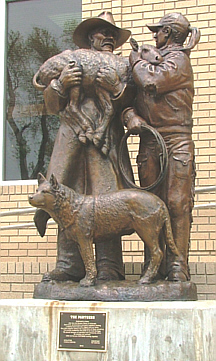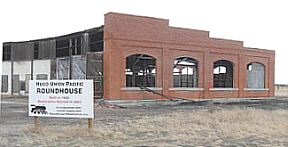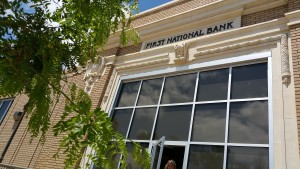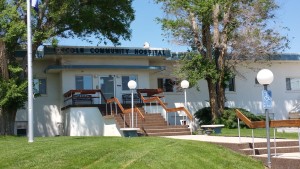Discover the 150 Year History of Hugo, Colorado
In the 1850s, a young white man from Missouri arrived in the area later known as Colorado. His name was John W. Barron, later known as “Cap” Barron.
Soon, gold was discovered in the Rocky Mountain, but to get to the gold, prospectors had to cross what New York newspaperman Horace Greeley dismissed as a region “of sterility and thirst.” This region was home to Cap Barron, and later was home to Hugo.
A couple of stage lines came through the area not long afterward; the Leavenworth & Pikes Peak line arrived in 1859 but was in business only a few months. The Butterfield Overland Dispatch arrived in 1864 and stayed longer. The B. O. D. located a station just west of present day Hugo, and called it “Hogan’s station.” Cap Barron became the B. O. D. agent at Hogan’s station, and had land in that area, including a plentiful supply of water, later known as Cap Barron’s Spring.
Ultimately, the company moved to a new station a mile or two to the east, called “Willow Springs.” A half-century later, Willow Springs became home to the Lincoln County Fairgrounds.
The railroad soon followed the stage lines; the Kansas Pacific Railroad began laying track west from Oakley, Kansas, and the further into Colorado the track extended, the shorter the stagecoach route from the end of the line to Denver became. Finally, the last stagecoach entered Denver on August 19, 1870, with the last ox team of freight not far ahead of it.
 The railroad located watering stops for its steam engines every few miles and division points—bases for employees and train repairs—about every 100 miles. One watering stop and division point was situated between Willow Springs and Hogan’s stations. It was called Hugo, possibly named after Hugo Richards, an Overland Stage Company employee who came to Denver from Atchison, Kansas in 1866 to become agent for the Overland Mail and Express Line.
The railroad located watering stops for its steam engines every few miles and division points—bases for employees and train repairs—about every 100 miles. One watering stop and division point was situated between Willow Springs and Hogan’s stations. It was called Hugo, possibly named after Hugo Richards, an Overland Stage Company employee who came to Denver from Atchison, Kansas in 1866 to become agent for the Overland Mail and Express Line.
The first people to actually live “in Hugo” were a couple of entrepreneurs, Clifford Rogers and William Hill. Rogers originally hailed from Massachusetts. Along with Hill, he was the first owner of the original Hugo town site, and he was a partner with Hill in the first business in the town, a general store. Why and when he went after leaving Hugo remains something of a mystery, but he ended up back on the East Coast.
William Hill was born in New Hampshire. A veteran of the Civil War, Hill later followed the railroad construction crews westward and arrived at Hugo “two days before the railroad did.” He never left, dying in Hugo 47 years after his arrival.
A post office was opened in December 1871, with Hill as postmaster.
The county’s first cemetery was located on Hill’s land, just over the hill north of Hugo. Prior to 1909, Hill apparently tired of discovering new bodies buried on his land without his knowledge or permission, and he served notice that use of his land for cemetery purposes was at an end. The present Evergreen Cemetery dates to that point.
Back in the gold rush days, herds of Texas longhorn beef cattle were driven north to serve the mining camps. Some of those cattlemen and their herders liked the looks of eastern Colorado, and the region between Kansas and the mountains became range for a handful of huge cattle operations. The first real cattle ranch operator in the Hugo area was Cap Barron.
 The area also appealed to immigrants from Scotland, who introduced the sheep industry here in the 1870s and ‘80s. Unlike areas in other parts of the West, sheep men and cattlemen generally got along here. Some of the cattlemen added sheep to their inventories, and many of the sheep men later got into the cattle business.
The area also appealed to immigrants from Scotland, who introduced the sheep industry here in the 1870s and ‘80s. Unlike areas in other parts of the West, sheep men and cattlemen generally got along here. Some of the cattlemen added sheep to their inventories, and many of the sheep men later got into the cattle business.
The Scottish settlers in the Hugo vicinity also introduced the game of golf to Hugo in the 19th Century.
Prior to the arrival of the railroad, Cap Barron’s place was situated just inside the Arapaho and Cheyenne Indian Reserve. But as the railroad arrived, the company officials decided they needed their own county, and the Territorial legislature created one for them, naming it after a railroad construction official, Colonel Greenwood. The town of Kit Carson boasted several thousand people then, so countyseat honors went to Kit Carson. It was a fleeting glory.
The rails moved on west, taking most of the people with them, and Greenwood County was abolished in 1874.
The county’s territory was itself carved up, with the northern end becoming Elbert County. Hugo was near the center of the new Elbert County empire, and Hugo residents were involved in the new county’s beginnings, with Clifford Rogers being appointed justice of the peace here. Cap Barron, William Hill and A. K. Clarke were called for the first jury. Clarke and rancher Frank T. Cochrane later served as Elbert County Commissioners, and Cap Barron was Elbert County’s sheriff for a term.
Colorado finally became a state in 1876. During this time, Hugo had its first newspaper, The Hugo Stayer, and a Chinese laundry, not to mention three hotels, two grocery stores, two carpenters, a general store, a blacksmith, a doctor…and of course, a beer hall. The town also had its first church when the Methodists moved into a former school building in 1885.
According to the 1880 Federal Census, Hugo boasted 140 citizens, of whom more than a third were employed by the railroad.
In 1888 and ‘89, another railroad was built north of Hugo, crossing the Union Pacific about 15 miles northwest of town and heading on to Colorado Springs. The Rock Island railroad also brought new towns into being, along with people to populate them, and suddenly, it was again time to create a new county.
This time, Lincoln County was carved out of Elbert and Bent counties, and Hugo became the county seat. Two Hugo residents serving as elected officials in Elbert County at the time were appointed to posts in the new county: Addison K. LaDue was the first county clerk and John W. “Rawhide” Williams was the first county judge. Williams, who later became a doctor, ultimately was remembered at Moab, Utah as the father of the Arches National Monument.
Everyone was riding high. Colorado gave women the right to vote, and a Hugo woman, Harriet L. Dunaway, was immediately elected Lincoln County Superintendent of Schools. The town got its first slot machine and its first gramophone, and the first public lending library was set up at the school.
 Then the railroad closed its roundhouse at Hugo and moved the division point to Cheyenne Wells. Town merchants tightened their belts and wondered if they should look elsewhere for their livelihood. But, by and large, the town hung on. In fact, the first Catholic church building was built in Hugo during this time. Most of the Hugo merchants were surprised at how well they could get along without the railroad business, and, with the help of the area livestock growers, they even began promoting the town.
Then the railroad closed its roundhouse at Hugo and moved the division point to Cheyenne Wells. Town merchants tightened their belts and wondered if they should look elsewhere for their livelihood. But, by and large, the town hung on. In fact, the first Catholic church building was built in Hugo during this time. Most of the Hugo merchants were surprised at how well they could get along without the railroad business, and, with the help of the area livestock growers, they even began promoting the town.
Probably the most famous promotion occurred when local folks learned that Theodore Roosevelt would be passing through on the Union Pacific en route to a speaking engagement at Denver. They promptly invited the President to stop at Hugo. The President politely declined, claiming a too-tight schedule, but the Hugo boosters were not put off by this response. They moved forward with their plans, just as though T. R. was eager to visit.
The occasion was well advertised, and when the presidential train pulled into Hugo early on the morning of May 4, 1903, some 2,000 people had gathered from miles around to greet it.
The spring round-up was just beginning, and the cowboys hosted breakfast near the tracks. The brother of the round-up foreman was a photographer, and he recorded the event with his camera. A newspaper reporter from Denver also was there. He later told his readers that the President stepped out of his car to make his excuses, but smelling the fresh-cooked steak, potatoes and hot coffee, he leaped from the train and filled his own plate!
This 15-minute Presidential visit pretty well coincided with the end of the open range and the undisputed reign of livestock country. Vacant public lands became available under the Homestead Act, the U. S. Land Office was located in Hugo, and people wanting free land swarmed the county and its neighbors. In little more than a decade, all of the available land was claimed. Tarpaper shacks or sod houses could be found on most quarter-sections, and their occupants were out scratching in the dirt, planting whatever seeds they could acquire, and eventually fencing out the free-ranging livestock.
 Hugo’s first bank opened in 1903 in a small, wooden building that stood between two saloons. Later, the wooden building was moved around the corner, and was replaced by a substantial brick bank building. The bank continues in business to the present day.
Hugo’s first bank opened in 1903 in a small, wooden building that stood between two saloons. Later, the wooden building was moved around the corner, and was replaced by a substantial brick bank building. The bank continues in business to the present day.
In 1904, telephone service came to Hugo, and in 1907, Hugo merchants were thrilled to learn that the Union Pacific planned to move the division point back to Hugo, and that a new brick roundhouse would be built west of the depot. It took two years to actually have the roundhouse up and running.
The enthusiasm generated by the return of the railroad employees to Hugo brought calls for incorporation, and Hugo became the first incorporated town in Lincoln County in late 1909, by a vote of 70 to 9. Elected to head the new town government was the first mayor, Ferdinand Vogel, a carpenter who had arrived in Hugo only the year before. Vogel later served as a state representative before he died in 1914.
Other signs of the town’s new prosperity included the arrival in 1909 of the Episcopal church in Hugo (which became home to the Lutherans, years later), and in 1910, creation of the first volunteer fire department, with E. E. Jones as fire chief.
In 1911, Dr. H. Edward Bacon built the first brick home in Hugo, and the Cobb and Platt Garage installed a dynamo to furnish electric lights for the Cobb & Daniel hardware store and for the Wilson & Matheson mercantile.
Hugo initiated the first municipal water system in 1912. Remnants of that first water system are still in use, including the water storage tank. The town only recently retired the last of the original fire hydrants.
Over the next half-century, Hugo felt everything that affected the nation. When the heady days of the Roaring Twenties came to the rest of America, they came to Hugo, too, and the citizens were full of fun, frolic and great expectations for the future. When the stock market crashed and the Great Depression struck, Hugo tightened its belt along with all the rest and sent its breadwinners to earn their living with some of President Franklin D. Roosevelt’s employment programs.
In fact, those programs helped the town in other ways. The Works Progress Administration built a new school gymnasium that now serves as a town hall, library and community building, and also built a new swimming pool that received National Historic Landmark designation in 2008. A local Civilian Conservation Corps camp did much to stop erosion and to control the grasshopper hordes that tried to wipe out whatever the dust bowl and the Depression had left standing.
World War II arrived, and Hugo and America sent more of their young men to fight and die in far-off places. One of those young men was Joe Will, a handsome young man said by some to be “full of the very devil.” Joe and his ship, the U. S. S. Arizona, were lost when the Japanese bombed Pearl Harbor in 1941. He was immortalized when the Joe Will Post 6612, Veterans of Foreign Wars was organized.
 More prosperity followed the war. Local residents built a new hospital and nursing home in the 1950s, using a lot of donated materials and labor.
More prosperity followed the war. Local residents built a new hospital and nursing home in the 1950s, using a lot of donated materials and labor.
Nevertheless, the clock was ticking in Hugo. The railroads changed from steam engines to diesels for their trains, and the need for the division point and its crews diminished. The roundhouse finally closed in the 1950s, with the handsome brick structure later used as a hardware and implement dealership for a time.
By the early 1970s, the railroad had ended local freight and passenger service on its trains, and the Hugo depot was closed around 1971.
Today, farms remain in the Hugo area…fewer farms, perhaps, but larger ones…and a local beef industry remains, as well. The Hugo community is still a viable one. With a population that hovers between 700 and 800, different businesses have come and gone, but the core economic elements of the town remain.
Yes, Hugo has more history to write!
Lincoln County Tourism Site
To discover more about Hugo and things to do in the surrounding Lincoln County, Colorado, visit: http://SeeLincolnCounty.com



